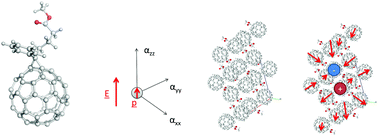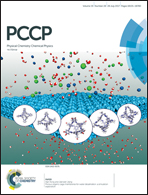The impact of chemical structure and molecular packing on the electronic polarisation of fullerene arrays†
Abstract
Electronic polarisation contributes to the electronic landscape as seen by separating charges in organic materials. The nature of electronic polarisation depends on the polarisability, density, and arrangement of polarisable molecules. In this paper, we introduce a microscopic, coarse-grained model in which we treat each molecule as a polarisable site, and use an array of such polarisable dipoles to calculate the electric field and associated energy of any arrangement of charges in the medium. The model incorporates chemical structure via the molecular polarisability and molecular packing patterns via the structure of the array. We use this model to calculate energies of charge pairs undergoing separation in finite fullerene lattices of different chemical and crystal structures. The effective dielectric constants that we estimate from this approach are in good quantitative agreement with those measured experimentally in C60 and phenyl-C61-butyric acid methyl ester (PCBM) films, but we find significant differences in dielectric constant depending on packing and on direction of separation, which we rationalise in terms of density of polarisable fullerene cages in regions of high field. In general, we find lattices containing molecules of more isotropic polarisability tensors exhibit higher dielectric constants. By exploring several model systems we conclude that differences in molecular polarisability (and therefore, chemical structure) appear to be less important than differences in molecular packing and separation direction in determining the energetic landscape for charge separation. We note that the results are relevant for finite lattices, but not necessarily for infinite systems. We propose that the model could be used to design molecular systems for effective electronic screening.



 Please wait while we load your content...
Please wait while we load your content...